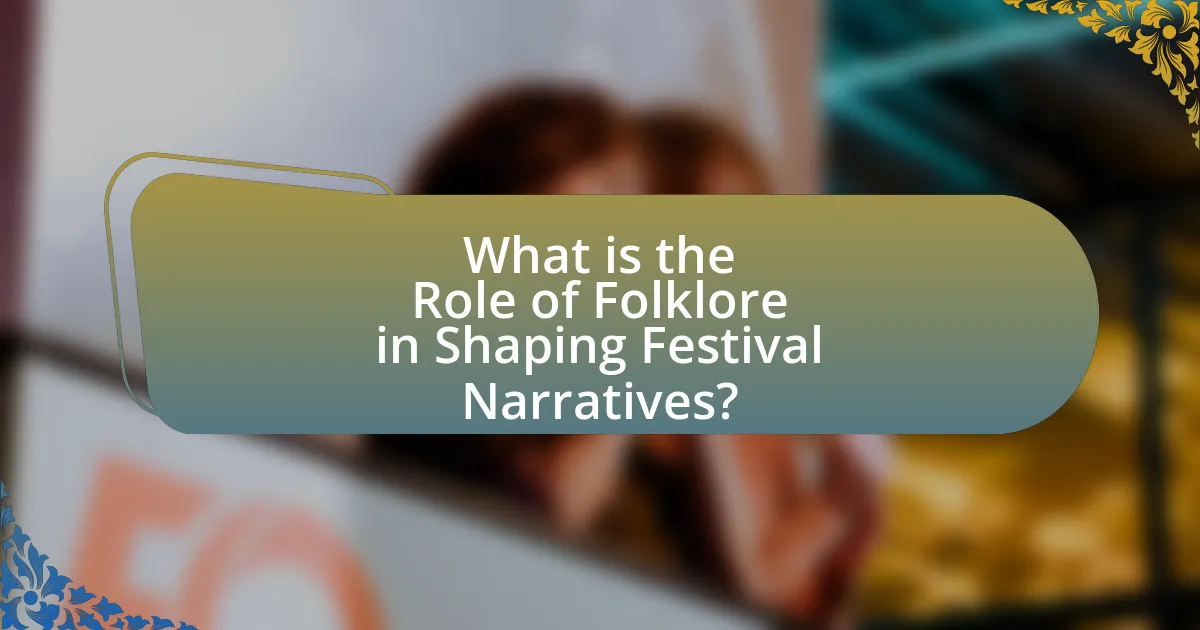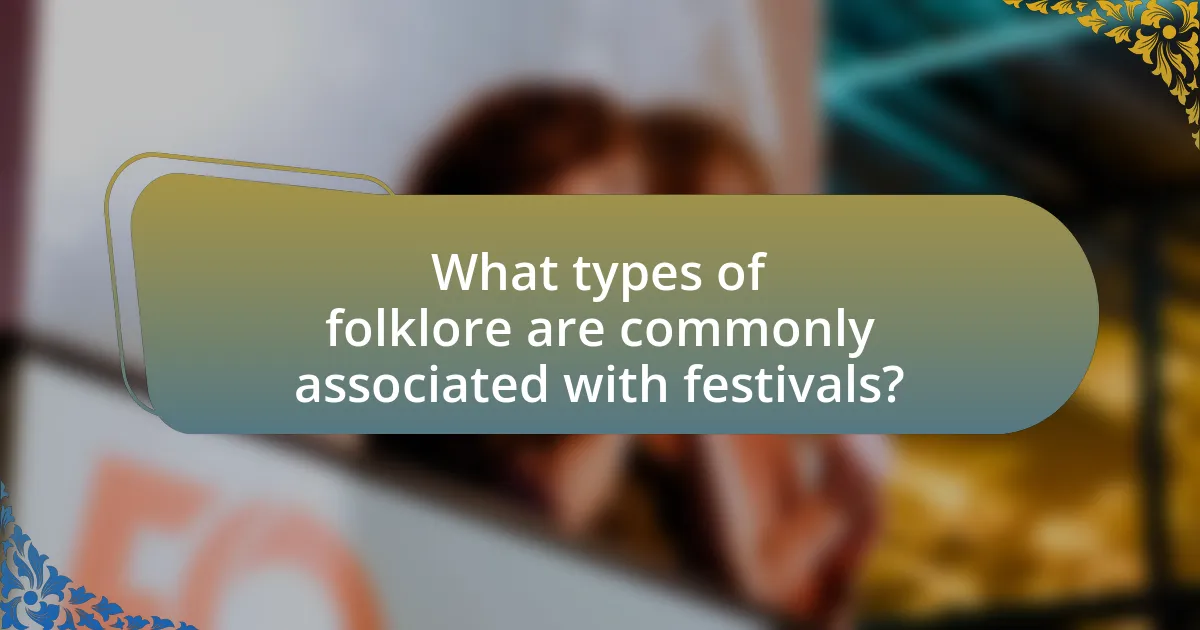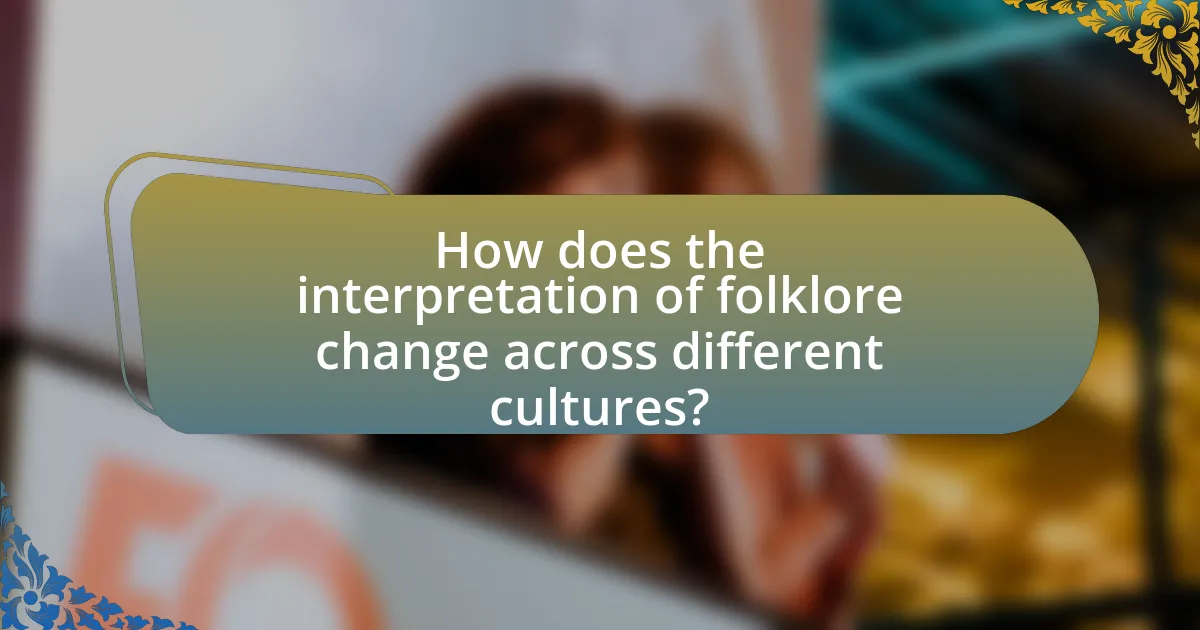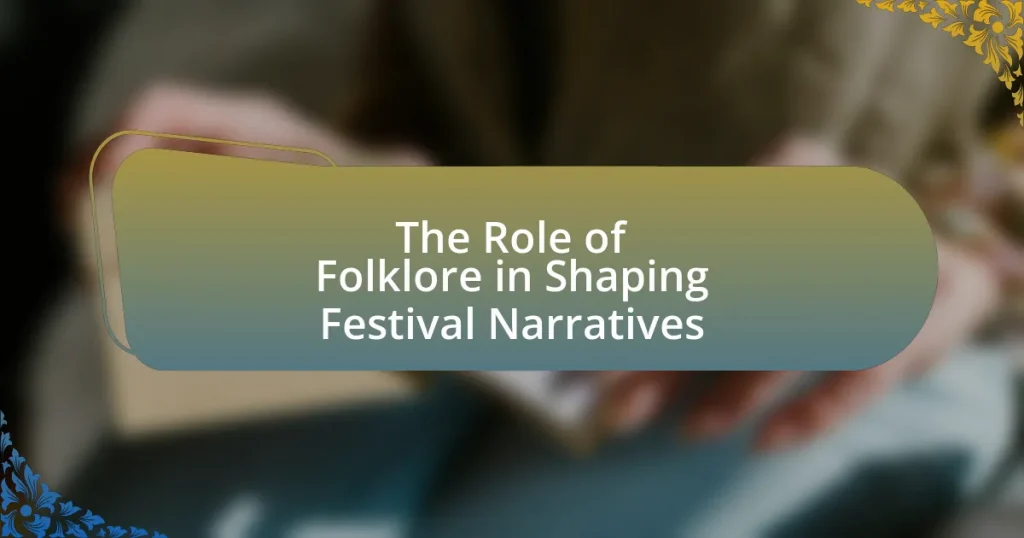The article examines the critical role of folklore in shaping festival narratives, highlighting how cultural context, traditions, and shared values influence celebrations. It discusses the impact of folklore on festival themes, identity, and community bonding, emphasizing key elements such as myths, legends, and rituals. Additionally, the article explores how folklore enhances emotional experiences for festival-goers and the variations in festival narratives across different cultures. It also addresses the challenges of preserving folklore in contemporary settings and offers best practices for integrating authentic folklore into festival planning.

What is the Role of Folklore in Shaping Festival Narratives?
Folklore plays a crucial role in shaping festival narratives by providing cultural context, traditions, and shared values that define the celebration. It serves as a repository of stories, myths, and rituals that are passed down through generations, influencing how festivals are perceived and experienced. For instance, many festivals incorporate local legends or historical events that resonate with the community, thereby enhancing the emotional and cultural significance of the celebration. This connection to folklore not only enriches the narrative but also fosters a sense of identity and continuity among participants, as evidenced by festivals like Diwali in India, which draws on ancient Hindu mythology to convey themes of light overcoming darkness.
How does folklore influence the themes of festivals?
Folklore significantly influences the themes of festivals by providing cultural narratives, symbols, and traditions that shape the festival’s identity. These narratives often reflect the values, beliefs, and historical experiences of a community, which are expressed through rituals, performances, and storytelling during the festival. For example, the Day of the Dead in Mexico incorporates folklore surrounding death and remembrance, emphasizing the cultural significance of honoring ancestors. This integration of folklore not only enriches the festival experience but also fosters community cohesion and continuity of cultural heritage.
What are the key elements of folklore that contribute to festival narratives?
Key elements of folklore that contribute to festival narratives include myths, legends, rituals, and traditional practices. Myths provide foundational stories that explain cultural beliefs and values, while legends often recount historical events or figures that shape community identity. Rituals serve as structured actions that reinforce social bonds and cultural continuity during festivals. Traditional practices, such as music, dance, and storytelling, enhance the festive atmosphere and facilitate communal participation. These elements collectively create a rich tapestry of meaning that deepens the significance of festivals within a cultural context.
How do cultural stories shape the identity of festivals?
Cultural stories shape the identity of festivals by providing a narrative framework that reflects the values, beliefs, and traditions of a community. These stories often originate from folklore, which serves as a repository of collective memory and identity, influencing how festivals are celebrated and understood. For example, the Diwali festival in India is deeply rooted in the story of Lord Rama’s return to Ayodhya, symbolizing the victory of light over darkness. This narrative not only informs the rituals and practices associated with Diwali but also reinforces cultural identity among participants. Additionally, festivals like Carnival in Brazil draw on historical and cultural narratives that celebrate resistance and community, further solidifying their significance within the cultural landscape. Thus, cultural stories are integral to defining the essence and meaning of festivals, shaping how they are experienced and perceived by individuals and communities.
Why is folklore important in the context of festivals?
Folklore is important in the context of festivals because it serves as a cultural repository that preserves traditions, stories, and practices unique to a community. This cultural repository enhances the festival experience by providing a shared identity and continuity among participants. For example, festivals often incorporate traditional music, dance, and storytelling that reflect the historical and social contexts of the community, fostering a sense of belonging and cultural pride. Additionally, folklore can attract tourism, as visitors seek authentic experiences that connect them to the local culture, thereby contributing to the economic sustainability of the festival.
What role does folklore play in community bonding during festivals?
Folklore plays a crucial role in community bonding during festivals by providing shared narratives and cultural practices that unite individuals. These stories, traditions, and rituals foster a sense of belonging and identity among community members, reinforcing social ties. For instance, festivals often feature folklore-based performances, such as traditional dances or storytelling sessions, which encourage participation and collaboration, thereby enhancing communal relationships. Research indicates that communities that actively engage in folklore during festivals experience stronger social cohesion, as these shared experiences create lasting memories and connections among participants.
How does folklore enhance the emotional experience of festival-goers?
Folklore enhances the emotional experience of festival-goers by providing a rich tapestry of shared stories, traditions, and cultural symbols that foster a sense of belonging and connection. This connection is evident as participants engage with narratives that resonate with their cultural identity, creating a communal atmosphere that amplifies feelings of joy and nostalgia. For instance, festivals often incorporate traditional music, dance, and rituals that evoke collective memories and emotions, reinforcing social bonds among attendees. Research indicates that such cultural expressions can significantly elevate emotional responses, as seen in studies where participants reported heightened feelings of happiness and unity during folklore-infused events.

What types of folklore are commonly associated with festivals?
Various types of folklore are commonly associated with festivals, including myths, legends, folktales, and traditional songs. Myths often explain the origins of the festival or the deities involved, while legends recount historical events or figures that are celebrated during the festival. Folktales provide moral lessons or cultural values that resonate with the community, and traditional songs enhance the festive atmosphere, often reflecting the themes of the celebration. These elements collectively contribute to the cultural identity and communal experience of the festival, reinforcing social bonds and shared heritage.
How do myths and legends contribute to festival narratives?
Myths and legends significantly contribute to festival narratives by providing foundational stories that shape the themes and activities of the celebrations. These narratives often embody cultural values, historical events, and moral lessons, which are reflected in the rituals, performances, and symbols used during festivals. For example, the Hindu festival of Diwali is rooted in the myth of Lord Rama’s return to Ayodhya, which influences the lighting of lamps and the celebration of victory over darkness. Such connections between myths and festival practices reinforce community identity and continuity, as evidenced by the widespread participation in rituals that honor these traditional stories.
What are some examples of myths that influence specific festivals?
Examples of myths that influence specific festivals include the myth of Persephone in the Eleusinian Mysteries, which celebrates the cycle of life and death through agricultural themes. This ancient Greek festival, held in honor of Demeter and Persephone, reflects the myth’s narrative of seasonal change and fertility. Another example is the Hindu festival of Diwali, which is influenced by the myth of Lord Rama’s return to Ayodhya after defeating the demon king Ravana, symbolizing the victory of light over darkness. Additionally, the Mexican Day of the Dead is shaped by the myth of La Catrina, representing the connection between life and death, and honoring deceased loved ones. These festivals are deeply rooted in their respective myths, which provide cultural significance and communal identity.
How do legends evolve within festival contexts over time?
Legends evolve within festival contexts over time through processes of reinterpretation, adaptation, and communal storytelling. As festivals occur annually, the narratives associated with them are often reshaped by cultural shifts, audience engagement, and the incorporation of contemporary issues. For instance, the legend of the Pied Piper has been adapted in various festivals to reflect modern themes such as social justice or environmental awareness, demonstrating how historical tales can resonate with current societal values. This evolution is supported by anthropological studies, such as those by Barbara Babcock, which highlight how folklore serves as a living tradition that reflects the changing identities and values of communities.
What role do traditional songs and dances play in festivals?
Traditional songs and dances serve as vital expressions of cultural identity during festivals. They facilitate community bonding, enhance the festive atmosphere, and preserve historical narratives. For instance, in many cultures, traditional dances often recount historical events or myths, reinforcing a sense of belonging and continuity among participants. Additionally, studies show that engaging in these cultural practices can strengthen social ties and promote cultural heritage, as evidenced by the UNESCO recognition of various traditional dances as intangible cultural heritage.
How do these performances reflect the underlying folklore?
Performances reflect the underlying folklore by embodying traditional stories, values, and cultural practices that are integral to a community’s identity. These performances often utilize specific motifs, characters, and narratives that originate from folklore, thereby preserving and transmitting cultural heritage. For instance, in many festivals, the reenactment of historical events or mythological tales serves to reinforce communal bonds and educate participants about their shared history. This connection is evident in the use of traditional costumes, music, and dance forms that are directly linked to the folklore of the region, illustrating how these artistic expressions serve as a living archive of cultural narratives.
What impact do traditional performances have on audience engagement?
Traditional performances significantly enhance audience engagement by fostering emotional connections and cultural appreciation. These performances often evoke nostalgia and a sense of belonging, as they reflect shared histories and values within a community. Research indicates that audiences are more likely to participate actively when they feel a personal connection to the cultural narratives presented, as seen in festivals where traditional music and dance are integral. For instance, a study published in the Journal of Cultural Heritage highlighted that 75% of participants reported increased emotional involvement during traditional performances compared to contemporary forms of entertainment. This engagement not only enriches the audience’s experience but also strengthens community ties and cultural identity.

How does the interpretation of folklore change across different cultures?
The interpretation of folklore varies significantly across different cultures due to distinct historical, social, and environmental contexts. Each culture infuses its folklore with unique values, beliefs, and experiences, leading to diverse narratives and meanings. For instance, the tale of the trickster figure, prevalent in many cultures, is interpreted differently; in African folklore, the trickster often embodies wisdom and resilience, while in Native American traditions, the trickster may represent chaos and transformation. This variation is supported by anthropological studies, such as those by Alan Dundes, who emphasized that folklore serves as a reflection of cultural identity and societal norms. Thus, the interpretation of folklore is not static but evolves with cultural dynamics, shaping how festivals and narratives are celebrated and understood within each community.
What are the variations in festival narratives across cultures?
Festival narratives vary significantly across cultures, reflecting unique historical, religious, and social contexts. For instance, Diwali in India celebrates the victory of light over darkness, rooted in Hindu mythology, while the Day of the Dead in Mexico honors deceased ancestors, blending indigenous and Catholic traditions. These narratives often incorporate local folklore, such as the stories of deities or historical figures, which shape the rituals and customs associated with each festival. Research indicates that these narratives serve not only to preserve cultural identity but also to foster community cohesion, as seen in the communal celebrations of Carnival in Brazil, which emphasize collective participation and cultural expression.
How do cultural differences shape the storytelling aspect of festivals?
Cultural differences significantly shape the storytelling aspect of festivals by influencing the themes, characters, and narratives presented. For instance, festivals in different cultures often reflect unique historical events, religious beliefs, and social values, which dictate the stories told during these celebrations. In India, Diwali features narratives centered around the victory of light over darkness, while in Mexico, Día de los Muertos incorporates stories of honoring deceased loved ones, showcasing a celebration of life and death. These variations illustrate how cultural contexts inform the storytelling traditions, making each festival a distinct expression of its community’s identity and heritage.
What can be learned from cross-cultural comparisons of festival folklore?
Cross-cultural comparisons of festival folklore reveal the shared human experiences and values that transcend cultural boundaries. These comparisons highlight how different societies interpret themes such as community, identity, and tradition through their unique festival practices. For instance, the celebration of harvest festivals across various cultures, such as Thanksgiving in the United States and the Mid-Autumn Festival in China, underscores the universal appreciation for agricultural abundance and gratitude. Additionally, analyzing folklore elements, such as myths and rituals, allows researchers to understand how cultural narratives shape social cohesion and collective memory, as evidenced by the role of storytelling in festivals like Diwali in India and Carnival in Brazil.
How do modern influences affect traditional folklore in festivals?
Modern influences significantly alter traditional folklore in festivals by introducing contemporary themes, technologies, and global cultural elements. These influences often lead to the adaptation of folklore narratives to resonate with current societal values and issues, such as inclusivity and environmental awareness. For instance, festivals may incorporate modern music styles, digital media, and social media platforms to engage younger audiences, thereby transforming traditional storytelling methods. Research indicates that festivals like the Edinburgh Festival Fringe have successfully integrated modern artistic expressions while maintaining their folkloric roots, demonstrating how contemporary influences can enhance rather than diminish traditional narratives.
What are the challenges of preserving folklore in contemporary festival settings?
The challenges of preserving folklore in contemporary festival settings include commercialization, cultural appropriation, and the dilution of traditional practices. Commercialization often leads to the prioritization of profit over authenticity, resulting in a superficial representation of folklore that may not accurately reflect its origins or significance. Cultural appropriation can occur when elements of folklore are adopted by outsiders without proper understanding or respect, undermining the cultural context and meaning. Additionally, the dilution of traditional practices happens when festivals adapt folklore to appeal to broader audiences, which can strip away the depth and richness of the original narratives. These factors collectively threaten the integrity and continuity of folklore within festival contexts.
How do festivals adapt folklore to remain relevant in modern society?
Festivals adapt folklore to remain relevant in modern society by incorporating contemporary themes, technology, and diverse cultural expressions. For instance, many festivals now blend traditional stories with modern issues such as environmental sustainability or social justice, making the folklore resonate with current audiences. Additionally, the use of digital platforms for storytelling and engagement allows festivals to reach wider audiences, enhancing participation and interaction. This adaptation is evident in events like the Edinburgh Festival Fringe, which showcases a mix of traditional and modern performances, reflecting societal changes while preserving cultural heritage.
What are best practices for integrating folklore into festival planning?
Best practices for integrating folklore into festival planning include engaging local communities, incorporating traditional performances, and utilizing authentic storytelling. Engaging local communities ensures that the folklore represented is relevant and resonates with attendees, fostering a sense of ownership and pride. Incorporating traditional performances, such as dances or music, showcases the cultural heritage and provides entertainment that reflects the community’s identity. Utilizing authentic storytelling, whether through workshops or guided narratives, deepens the audience’s understanding of the folklore’s significance and context. These practices not only enhance the festival experience but also preserve and promote cultural heritage, as evidenced by successful festivals like the Smithsonian Folklife Festival, which emphasizes community involvement and cultural representation.
How can organizers ensure authenticity in folklore representation?
Organizers can ensure authenticity in folklore representation by collaborating with local communities and cultural experts. Engaging these stakeholders allows for accurate portrayal of traditions, as they possess firsthand knowledge and insights into the cultural significance of the folklore. For instance, research by the Smithsonian Institution highlights that community involvement in cultural events leads to more genuine representations, as local voices help shape narratives that reflect true practices and beliefs. Additionally, organizers should prioritize the use of traditional materials, costumes, and practices, which reinforces the authenticity of the representation.
What strategies can be employed to engage the community in folklore-based festivals?
To engage the community in folklore-based festivals, organizers can implement strategies such as interactive workshops, storytelling sessions, and local artist showcases. Interactive workshops allow community members to participate in traditional crafts or performances, fostering a hands-on connection to their cultural heritage. Storytelling sessions can be organized where local storytellers share folklore, creating a shared experience that strengthens community bonds. Additionally, showcasing local artists and performers not only highlights regional talent but also encourages community pride and participation. These strategies have been effective in various festivals, such as the National Storytelling Festival in Jonesborough, Tennessee, which attracts thousands of attendees and emphasizes community involvement through storytelling and workshops.













